
Figure 1. ICMS Methodologies


ICMS Methodologies.
ICMS has developed a set of methodologies and systems aimed at the identification and evaluation of Intellectual Capital Management in organisations, with a view to making these as efficient and effective as possible. We aim to identify the essential knowledge, core competencies, and core capabilities of an organisation that directly or indirectly produce value. ICMS methodologies and systems are easily implemented through the software packages that are specifically developed in each case. Among these, the most relevant are the following:

In the face of uncertain, complex, hipercompetitive, and turbulent environments, the life expectancies of products shorten, and the preferences and needs of customers change very quickly. In this context, it is difficult for companies to base their strategies on the market needs that they want to satisfy. Rather, they must consider the market needs that they can satisfy-taking into account their available resources and, more importantly, their available capabilities. This means that an external orientation cannot be the only foundation of a strategy, as it was in the past. To face the new challenges, the modern foundation of strategy must be an internal orientation-based on the available resources and capabilities. In general, as environments become more turbulent, it becomes increasingly sensible to base the strategy on identifiable internal resources and capabilities, rather than on uncertain external factors.
These vital capabilities are the result of unique combinations of resources (both tangible and intangible) that the company develops when applying their activities and processes to the task at hand. Among these various capabilities, core capabilities are the most relevant, because they represent the main source of sustainable competitive advantage. In our view, these "core capabilities" (or "core competencies") can be equated with the "intellectual capital" of an organisation and, in the turbulent and dynamic environments of today, companies therefore effectively compete on the basis of their intellectual capital or their core capabilities in seeking to attain a sustainable competitive advantage.
Figure 2 illustrates how competitive strategies work in the dynamic environments
of the modern era.
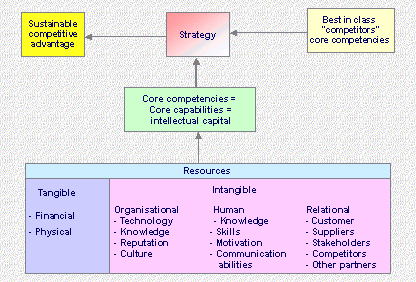
Having stated the essential nature of strategy formulation in today's dynamic environments, and how they need to be based on internal core capabilities, it is important to note that strategy formulation has different features when dealing with the innovation process as compared with the operations process.
In practice, the process of value creation in companies and organisations can be considered in these two broad divisions of innovation and operations. The core capabilities of an organisation in innovation can be very different from its core capabilities in operations.
The process of innovation, with its corresponding "innovation value chain", is the process that of developing the new products and services (and the new processes for providing them) that subsequently feed the operations process. The innovation process is especially important in the knowledge economy-in which products, services, processes, and technologies become rapidly obsolete. As a consequence, many companies and organisations now base their competitiveness on their innovation capabilities. In doing so, they are effectively basing their competitiveness on what might be termed their "innovation intellectual capital".
The process of operations, which produces "ordinary" products and services through a systematic and repetitive "operations value chain", also requires core competencies and core capabilities to be competitive. However, these competencies and capabilities are usually of a different nature from those of the innovation process. The core competencies and core capabilities of operations can also be termed "operations intellectual capital".
Figure 3. illustrates the business process broken down into its two constituent value chains-the innovation value chain and the operations value chain.
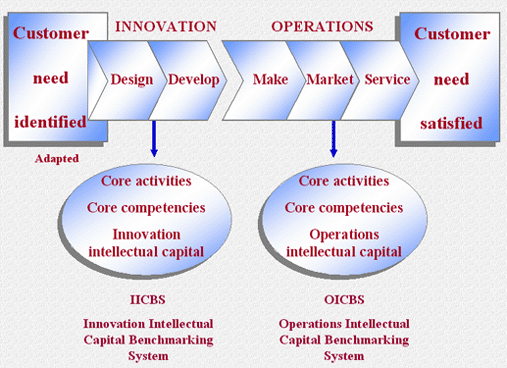

a. OICBS: Operations Intellectual Capital Benchmarking System.
AN OPERATIONS INTELLECTUAL CAPITAL STRATEGIC MANAGEMENT METHODOLOGY.
A company performing its current operations activities can be thought of as
a tree in which the visible parts of the tree (the trunk, the branches, the
leaves, and the fruits) correspond to the tangible assets of the company (see
Figure 4). The invisible part of the tree (the roots of the tree below ground)
corresponds to the intangible assets of the company. Just as the two parts of
a tree are inseparable, so are the tangible and intangible assets of a company.
The roots of the tree collect the essential nutrients, and then the sap is sent
through the trunk and the branches to the leaves and fruits. In a similar way,
knowledge and its aggregates-competencies, capabilities, and intellectual capital-make
up the business "sap" that flows from the roots to the processes, and thus to
the products and services.
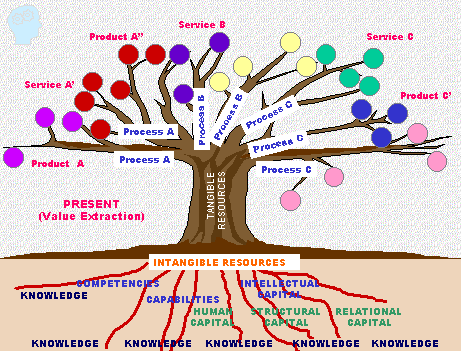
Continuing with the idea of a company as a tree, each company business unit
can be considered to be a specific tree, and the whole company has as many trees
as it has business units. Each of these trees is fed with the knowledge of its
roots. Furthermore, a company has at its disposal a common intangible operations
infrastructure that is shared by all its business units. This infrastructure
corresponds to the fertile soil in which all the company trees are planted.
This fertile soil nourishes the roots (core knowledge) of each individual company
tree. See Figure 5.
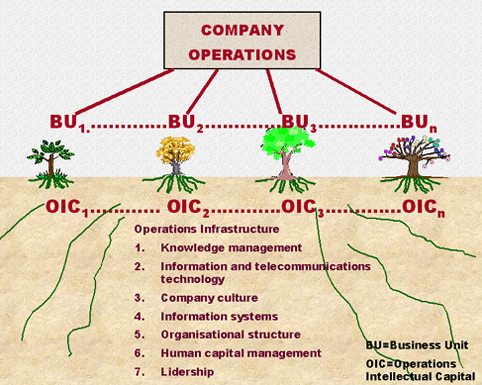
The OICBS methodology draws inspiration from this idea of the company as a tree. The flowchart of Figure 6 is a summary representation of the OICBS working scheme whereas the flowchart of Figure 7 is a detailed representation of the same working scheme. Both flowcharts show that, within each company tree (or business unit), separate analyses can be made, in succession, of the leaves and fruits (the products and services), the branches (the processes), and the roots (the core competencies and professional core competencies). For this purpose, ad hoc personalised questionnaires can be used. In addition, the overall soil fertility (the operations infrastructure) can be analysed.
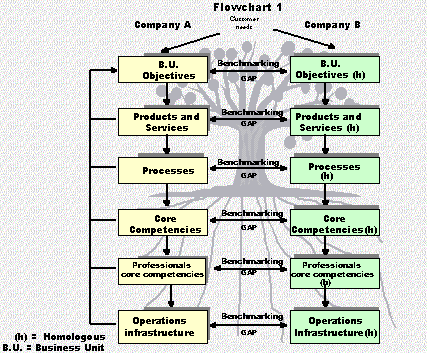
Figure 6. OICBS Operations Intellectual Capital Benchamrking System.
(Summary representation)
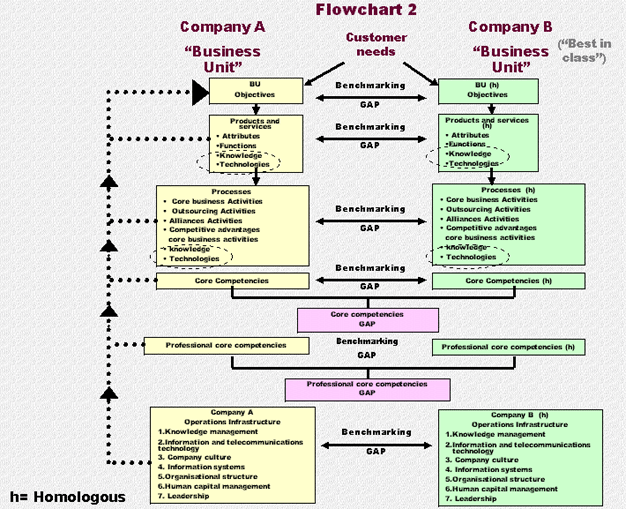
Figure 7. OICBS Operations Intellectual Capital Benchamrking System.
(Detailed representation)
In analysing each particular tree (that is, each individual business unit), we use the value chain as an analytical tool. See Figure 8.

All of the above-mentioned analyses have the ultimate purpose of discovering, in each of the steps or phases of the flowchart, the core knowledge and core technologies that are the prime sources of sustainable competitive advantages.
This methodology makes it possible to compare each specific tree (business unit) with the corresponding tree of the best of the competition, thus facilitating the benchmarking of leaves and fruits (products and services), branches (processes), roots (core competencies and professional core competencies), and soil fertility (operations infrastructure). The benchmarking process is shown in figures 6, 7 and 9. In these figures, the benchmarking gap gives the necessary information for taking appropriate corrective action and for learning from past errors.
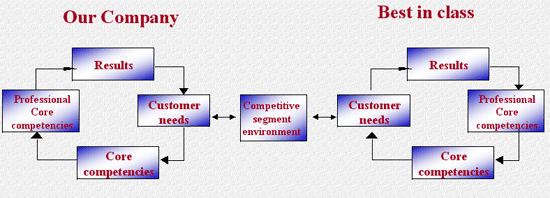
The benefits obtained from the systematic and ongoing use of OICBS methodology are summarized below.:

The idea of a company as a tree is also useful in assessing innovation activities. The visible parts of the tree (the trunk, the branches, the leaves, and the fruits) correspond to the tangible innovation assets of the company (see Figure 10). The invisible part of the tree (the roots below ground) corresponds to the intangible innovation assets of the company.
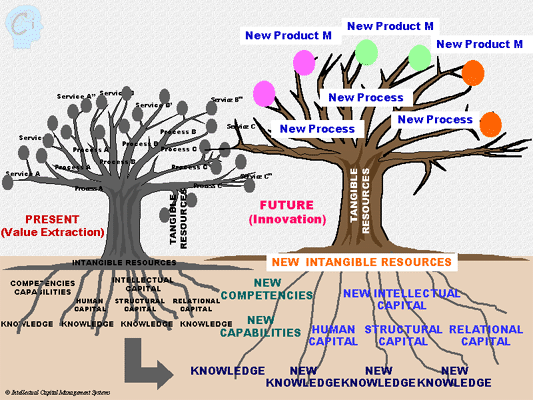
Just as the two parts of a tree are inseparable, so are the tangible and intangible assets of a company. The roots of the tree collect the essential nutrients, and then send the sap through the trunk and the branches to the leaves and fruits. In a similar way, new knowledge and its aggregates-new competencies, new capabilities, and new intellectual capital-make up the business "sap" that flows from the roots to the new processes, and thus to the new products and services.
Continuing with the idea of the new tree, each innovation project can be considered
to be a specific tree, and the whole company has as many trees as it has innovation
projects. Each of these trees is fed with the knowledge of its roots. Furthermore
a company has at its disposal a common intangible innovation infrastructure
that is shared by all the innovation projects. This infrastructure corresponds
to the fertile soil in which all the company innovation trees are planted. This
fertile soil nourishes the roots (core knowledge) of each innovation company
tree. See figure 11.
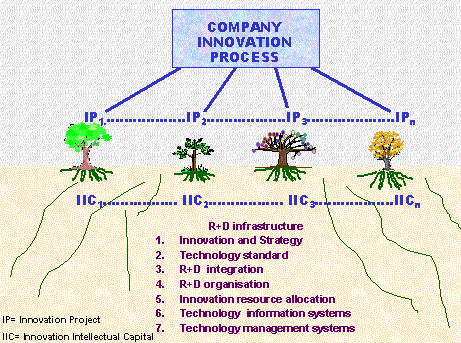
The IICBS methodology draws inspiration from this idea of the new tree. The flowchart of figure 12 is a summary representation of the IICBS working scheme. The flowchart shows that, within each new tree (or innovation project), separate analyses can be made, in succession, of the leaves and fruits (the new products and services), the branches (the new processes), and the roots (the new core competencies and new professional core competencies). For this purpose, ad hoc personalised questionnaires can be used. In addition, the overall soil fertility (the innovation infrastructure) can be analysed.
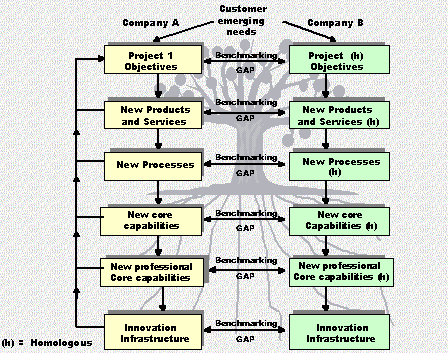

In analysing each particular tree (that is, each individual innovation project), we use the value chain as an analytical tool. See figure 14.

This methodology makes it possible to compare each specific tree (innovation project) with the corresponding tree of the best of the competition, thus facilitating the benchmarking of leaves and fruits (new products and services), branches (new processes), roots (new core competencies and new professional core competencies), and soil fertility (innovation infrastructure). The benchmarking process is shown in Figures 12, 13 and 15. In these figures, the benchmarking gap gives the necessary information for taking appropriate corrective action and for learning from past errors.
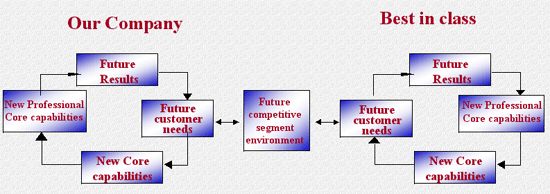
The benefits of using IICBS are:

The "resource-value" view stresses that, in turbulent times involving rapid changes in the needs of customers and industry, sustainable competitive advantage is mainly derived from the resources and capabilities of the company. More specifically, such advantage is derived from the core capabilities represented by the core competencies or intellectual capital of the organisation. In search of such sustainable competitive advantage, various models have been developed in recent times. These models manage intellectual capital of the two value chains-the operations value chain and the innovation value chain.
It is also important to note that, in the modern knowledge economy, organisations do not rely solely on their internal intellectual capital to build sustainable competitive advantage. They now rely also on the intellectual capital of other companies, organisations, and institutions-especially those of the cluster, microcluster, or territory in which the company is located. This kind of intellectual capital, basically external and of a relational nature, is one of the main constituents of the organisational network that can be referred to as "Social Capital"-because it is embedded in the social fabric of the organisation's environment.
SCBS (Social Capital Benchmarking System) is both a new management method and a new management tool that allows a company to benchmark the resources and capabilities of the cluster in which the company is located against the resources and capabilities of the best cluster in the world, with a view to developing the company's own business activities.
SCBS identifies, audits, and benchmarks the resources and capabilities represented in the company's social capital as they exist, and as they potentially exist in alternative cluster locations suitable for the development of the specific network organisation appropriate to each business model.
Figures 16 and 17 show that, in building internal core competencies, the intelligent
enterprise needs to cooperate with the resources and capabilities of other companies,
organisations and institutions. This cooperation entails relationships that
can be divided into two groups. The first group includes the resources and capabilities
inside the cluster, whereas the second group is made up of those outside the
cluster. Relationships inside the cluster are privileged relationships because
they allow personal contacts and provide access to tacit knowledge-the only
form of knowledge that guarantees long-term sustainable competitive advantage.
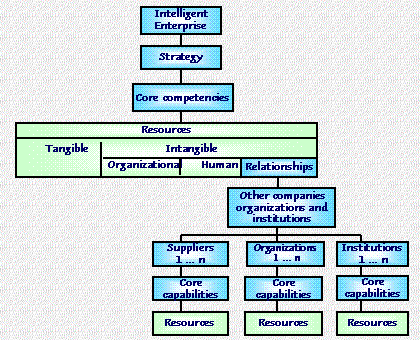
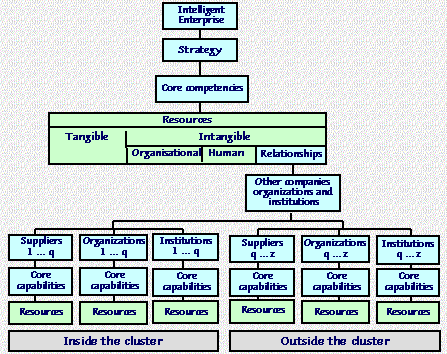
Figure 18 shows various alternative clusters in which a specific company can be located to build the required network organisation appropiate to a particular business model.
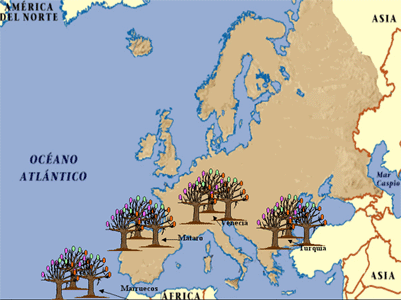
Figure 19 illustrates the "six-factor" model used for the evaluation of the social capital of being located in various alternative clusters. This model facilitates the selection of the most suitable cluster for a specific business design.

Figures 20 and 21 show the evaluation process of alternative clusters.
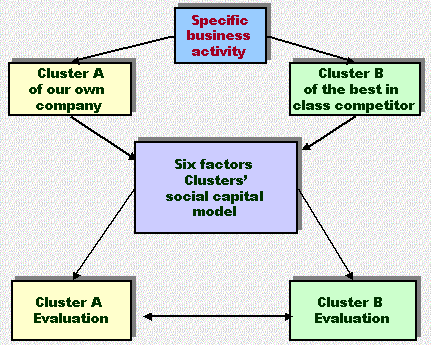
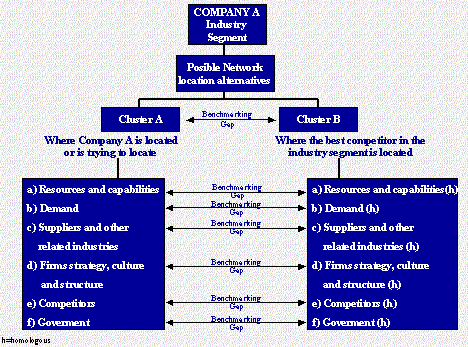
The benefits of using SCBS are as follows:

The governments of cities have to make important decisions on the future of their communities. In the past, the vision, objectives, and goals of cities have been determined mainly by considering tangible assets as the main factors of a city's prosperity. However, in the knowledge economy, the role of intangible assets in wealth creation has become fundamental. As a result, a framework of intangible assets that allows navigation from the present reality to the future vision has become an urgent need for all cities. The study has two well-defined parts. In the first part, it develops a specific methodology and framework for measuring and managing the intellectual capital of cities. In the second, the study deals with the practical application of this model of intellectual capital in cities to the specific case of the city of Mataró, providing some details of the first cities' intellectual capital report.
The benefits of using CICBS are as follows:
These systems and methodologies have been successfully piloted in a number of European enterprises of various types.
